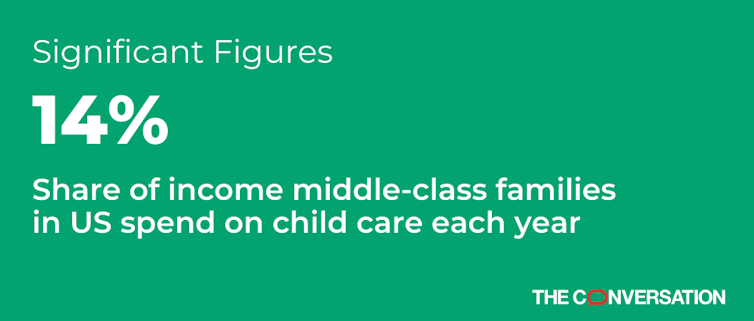US parents pay nearly double the 'affordable' cost for child care and preschool
The federal government spends about US$2,500 a year on child care and early education per child under 5, about half of the European average.


President Joe Biden wants to make child care more affordable across the U.S.
Under his American Families Plan, proposed in April 2021, the federal government would subsidize the costs of child care to the tune of US$225 billion annually. Lower-income families could access child care free of charge, while middle-class families would pay no more than 7% of their income.
Additionally, the plan seeks to make free, high-quality preschool available for all 3- and 4-year-olds.
Almost 60% of parents say preschool and day care expenses are a financial strain. Currently, child care eats up 14% of the incomes of middle-class working families – for example, those with a household income of $50,000-$100,000 for a family of four – according to the Center for American Progress, a progressive think tank. For lower-income families, the share rises to 35%
As a scholar who studies government support for working families in different countries, I know that the United States spends substantially less on early education and child care than comparable nations. While the U.S. spends approximately $2,500 a year on child care and early education per child, the average in Europe is $4,700. Some countries, including Norway and Sweden, spend more than $10,000.
Impact of limited funding
Given the devastating effects of the pandemic on child care in the U.S., as part of the 2021 American Rescue Plan the federal government has added $39 billion to support child care providers, and an additional $15 billion in flexible funding for states to make child care more affordable.
This is in addition to $10 billion provided as part of a December 2020 COVID-19 relief package. Yet these one-time infusions can’t solve the long-term lack of child care funding.
Federal spending is usually so limited that it reaches relatively few children. For example, the Child Care and Development Block Grant Act provides federal funding to states that provide child care subsidies for low-income families with children under 13. Yet only 15% of the nearly 14 million children who are eligible for these subsidies actually benefit from them.
Early Head Start and Head Start are free, federally funded programs that promote school readiness for children ages 3-5 from low-income families. Early Head Start serves only 11% of eligible children, and Head Start serves 36% of eligible children. Despite demand for Head Start services, inadequate funding limits how many kids the program can serve.
In other words, most working families cannot rely on these programs.
Benefits of subsidies
While the roughly $10 billion the federal government spends annually on Head Start and $5 billion on other child care programs may seem expensive, spending on early childhood education pays large dividends and boosts economic growth – effectively generating more revenue than the programs cost.
Research consistently shows that children enrolled in early education programs are more likely to go to college, earn more money, have better health and not receive public assistance.
Indeed, a 2016 study shows that every $1 the government spent on high-quality early childhood education programs in North Carolina led to a $7 benefit to the economy. More money spent on child care means less spent on other government benefits like unemployment insurance and Medicaid.
Effective models for pre-K
Biden’s American Families Plan also seeks to build on the work of successful state-funded preschool programs. Florida, the District of Columbia, Oklahoma and Vermont have adopted nearly universal pre-K for 4-year-olds, and some other states, counties and cities have begun to build these programs too. Universal pre-K programs are also being expanded to include 3-year-olds.
These programs work. For example, researchers studied the children who enrolled in the high-quality pre-K program in Tulsa, Oklahoma, as 4-year-olds after they reached middle school. They found the pre-K alumni had better math skills, took more honors courses and were less likely to be held back in school than 4-year-olds who did not take part in the program.
Yet as of 2021 relatively few U.S. children can attend high-quality preschool. Wealthier families are more likely to enroll their kids in licensed child care centers, which often have an early education component. This reinforces the achievement gap between children from poorer and wealthier families.
Based on all the evidence available, I have no doubt that higher government spending on early education and child care could dramatically change the lives of working families, improve the long-term life trajectories for many Americans and strengthen the U.S. economy.
[Insight, in your inbox each day. You can get it with The Conversation’s email newsletter.]
Joya Misra receives funding from the National Science Foundation and Washington Center for Equitable Growth.
Read These Next
Midlife weight gain can start long before menopause – but you can take steps early on to help your b
What you do in the years leading up to menopause can help counter the natural hormonal effects of aging,…
How the ‘slayer rule’ might play a role in determining who will inherit wealth from Rob Reiner and h
These rules have a long history in the United States. They played a role in the notorious murders by…
The celibate, dancing Shakers were once seen as a threat to society – 250 years later, they’re part
‘The Testament of Ann Lee,’ Mona Fastvold’s 2025 film, depicts part of the long history of Shaker…






